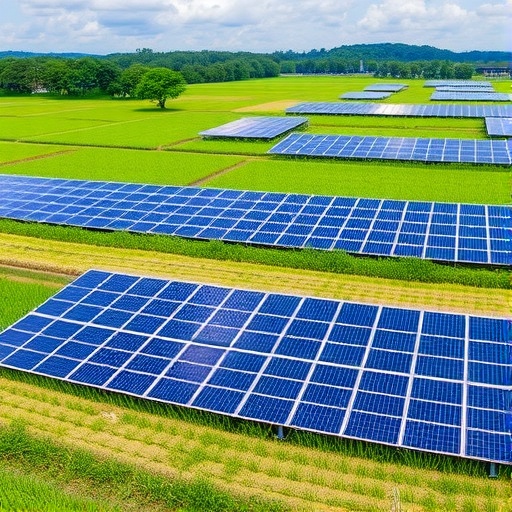In the evolving landscape of renewable energy, the imperative to optimize land use without compromising food production has become a critical challenge worldwide. Nowhere is this tension more pronounced than in Japan, where rugged mountainous terrain restricts the availability of flat arable land. A pioneering study emerging from the University of Tokyo offers a visionary approach to this dilemma by merging solar energy generation with traditional rice cultivation. This integration, known as agrivoltaics, transcends conventional separate uses of land, facilitating simultaneous agricultural productivity and clean energy generation.
At the heart of this study is the implementation of a sophisticated dual-axis sun-tracking photovoltaic (PV) system delicately installed above a rice paddy in Miyada-mura, Nagano Prefecture. Elevated three meters above ground level, the solar panel array allows rice plants beneath to receive filtered sunlight essential for photosynthesis, while consistently harvesting solar radiation to generate electricity. The panels’ ability to tilt and track the sun’s position dynamically, both daily and seasonally, introduces an innovative form of adaptive shading, which is key to balancing the conflicting demands of crop growth and photovoltaic efficiency.
This dual-axis tracking system is engineered to modulate the angle of PV panels based on temporal agricultural priorities. During the crucial growing season, the system optimizes panel orientation to minimize shading on the rice plants, ensuring they receive adequate sunlight required for biomass accumulation and grain development. Conversely, during off-peak agricultural periods, the panels pivot to maximize solar exposure and boost electricity generation. This intelligent, mix-use strategy represents a fine-tuned compromise between the biological requirements of rice and the technical parameters governing solar power output.
Over the course of two full growing seasons, the agrivoltaic installation demonstrated robust performance in both arenas. Rice yield, a critical metric of agricultural viability, initially registered at approximately 75 percent of yields seen in adjacent traditional paddies during the first year of operation. However, after iterative adjustments to panel positioning and shading management, yields rebounded impressively to 85 percent in the subsequent season. Importantly, the harvested rice met Japan’s stringent grain quality standards, underscoring that the integrated system did not detrimentally impact crop quality.
From an energy perspective, the dual-axis agrivoltaic setup generated an estimated annual output of nearly 44,000 kilowatt-hours. This figure corresponds to an electricity yield efficiency of 961.4 kilowatt-hours per kilowatt of installed capacity, positioning the system favorably against comparable solar energy installations across Europe. By maintaining a balance between shading for crop health and maximizing photovoltaic conversion, the system achieves a synergistic effect that neither standalone farming nor solar deployment could attain.
Economically, the study’s projections over a 20-year operational horizon are promising. The levelized cost of electricity production was calculated to be approximately 27 yen per kilowatt-hour without relying on government subsidies. This cost is roughly on par with the prevailing household electricity rates in Japan, indicating the agrivoltaic scheme’s potential to compete commercially while delivering environmental benefits.
The technical brilliance of this approach lies in its capacity to negotiate the intricate tradeoffs inherent in dual land use. Shading, typically perceived as an impediment to crop productivity, is meticulously managed through dynamic panel angling enabled by the dual-axis tracking mechanism. This flexible shading regime allows for real-time optimization, adapting to seasonal solar trajectories and crop developmental stages, which effectively harmonizes the two land uses.
Looking toward the future, the researchers envision incorporating advanced artificial intelligence algorithms to further refine this balancing act. By leveraging AI, it becomes feasible to process vast datasets of sunlight intensity, weather patterns, and crop growth metrics to dynamically adjust panel angles with unrivaled precision. This would ensure optimal sunlight distribution, potentially enhancing both energy production and crop yields.
Further innovation may come from deploying next-generation photovoltaic technologies. The use of semi-transparent or high-efficiency solar panels could reduce the impact of shading even more, allowing greater light penetration without sacrificing considerable energy conversion capabilities. Such materials could revolutionize agrivoltaics by tightening the synergy between photosynthesis requirements and photovoltaic performance.
Japan’s national ambitions to drastically expand its solar energy capacity by 2030 make this agrivoltaic model particularly timely. As the country grapples with limited land resources, integrating renewable energy infrastructure with staple crop production represents an elegant strategy. It holds promise not only for energy security and sustainability but also for supporting rural economies where agriculture remains a cornerstone.
Beyond Japan, this study offers a scalable blueprint applicable worldwide in regions facing similar land constraints. The fusion of engineering and agriculture embodied in agrivoltaics opens a new frontier of land use efficiency that harmonizes ecological stewardship, technological innovation, and food security.
In summary, the University of Tokyo’s research on rice farming under a dual-axis sun-tracking agrivoltaic system exemplifies how thoughtful design and interdisciplinary collaboration can address pressing global challenges. Through careful modulation of shading, adaptive solar panel dynamics, and integration of cutting-edge technologies, dual land use systems can achieve remarkable productivity and sustainability goals simultaneously. As interest in agrivoltaics grows, such pioneering studies will be pivotal in guiding policy, investment, and technological development trajectories that align with a resilient, low-carbon future.
Subject of Research: Agrivoltaic dual-use systems integrating photovoltaic technology with rice cultivation in Japan.
Article Title: Case study of rice farming in Japan under agrivoltaic system.
News Publication Date: 4-Aug-2025.
References:
Y. Okada et al., “Case study of rice farming in Japan under agriphotovoltaic system,” J. Photon. Energy 15(3), 032704 (2025), doi: 10.1117/1.JPE.15.032704.
Image Credits: Y. Okada et al., doi 10.1117/1.JPE.15.032704.
Keywords: Photovoltaics, Agriculture, Agricultural engineering, Farming, Food science.




